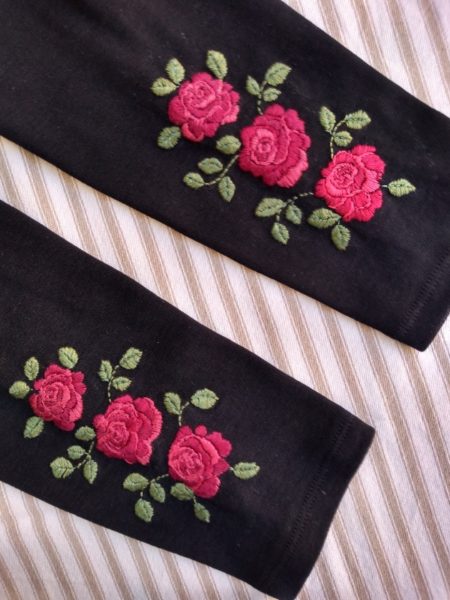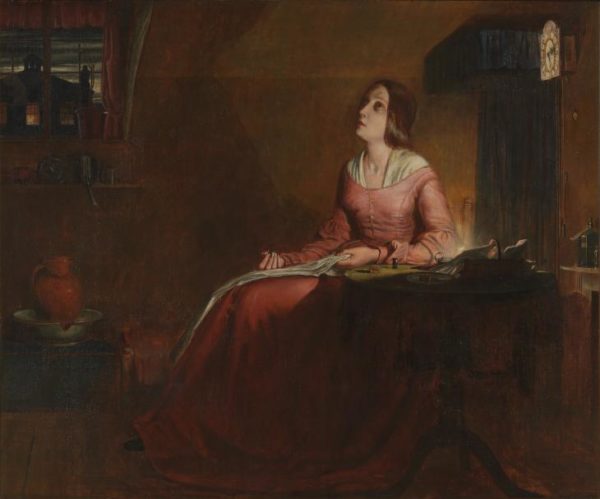
Book of Kells style A (hand embroidered by Mary Addison)
Having been in T shirt embellishing mode recently, I recklessly thought it was time I did something for my son. When I first suggested the idea he looked a bit hesitant but perked up when I started talking of an initial in the style of the Book of Kells, whose strongly entwined patterns I know he likes. Now I’ve finished the T shirt I think the yellow and red are a bit bright – my supply of jersey for appliqué is limited. I have a feeling that after I show it to him next week when I go to London, I may well end up soaking it in a bath of warm tea which is always a good way to take the edge off the colours. If that fails, we shall just have to write it off to experience and he can use it for house painting, gardening, climbing mountains, etc. What is life without a bit of experimentation even if it doesn’t quite work?

T shirt with Book of Kells style A (hand embroidered by Mary Addison)
For the last of my husband’s latest art appreciation sessions which focused on looking at paintings of people at work, we were a small, select group of about 8 (not including Chapel Arts staff, at least one of whom draws up his chair to look and listen). Coming straight after a Bank Holiday people were away doing other things which is to be expected. However, sometimes being part of a smaller group enables people to open up and join in with their own experiences, which are often eye openingly interesting or at the very least informative – one man explained the complexities of water management as we looked at a Constable Stour valley painting while on another occasion a depiction of the annual Rushcart festival at Saddleworth Church in 1828 caused a bit of a Morris-dancing-on-the-green sort of titter – rightfully silenced when someone pointed out that she’d lived in that village and that moreover, the rush festival – still celebrated – was as important a date on the calendar as the harvest festival. Architects and engineers are always useful in the audience, although sometimes the brave soul who says they haven’t a clue as to what a painting is about can be the very best person to have around. Last week paintings of factory work during the second World War initiated a conversation about how women had enjoyed some of the most physical of factory work while men were away fighting. One woman’s mother had worked in a munitions factory, while another woman’s grandmother had worked as a welder and really enjoyed it – for a while we were all very Foyle’s War. It was interesting though that two out of eight of those present had direct knowledge from relatives with such experience – we are after all 70 + years on from WWII.

April has in the main been unusually dry but crossing Montpellier Gardens after rain one day our noses were greeted by that most lovely of smells – no not cut grass after lawn mowing, although that’s pretty glorious, but the scent of rain on earth that has been dry for just that bit too long. And what is even more wonderful is that I’ve just discovered this sublime fragrance has a lovely name – petrichor (from the Greek ‘petra’ meaning stone and ‘ichor’ which is the word for the ethereal blood of the gods). The word dates back to just 1964 when Australian scientists isolated the chemicals involved. Petrichor refers to both the scent and its chemical components, the most important of which is something called geosmin, the product of Streptomyces bacteria living in the soil. Also contributing to the smell are oils produced in plants’ roots which act to put a stop to growth and seed germination during dry spells. When a rain drop hits the dry earth, minute air bubbles capture the smell as they bounce off and upwards to passing nostrils and so give the human owners the familiar feeling of earthy wellbeing. Mmmmmm. Our neighbours’ mauve wisteria has rushed out with the sun this last week, so I’m hoping for only gentle falls of rain for the time being. It’s a wonderful time for a week in London as I shall catch another wisteria, this time white, which generously cascades more on our side than theirs. Oh, don’t you love spring!




